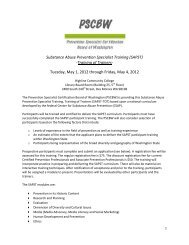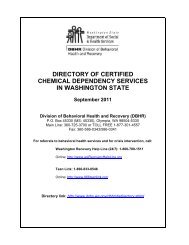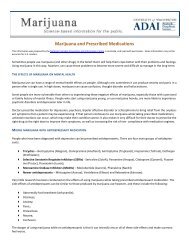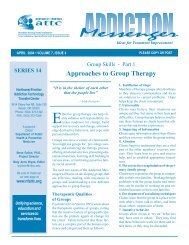Substance Use Initiation by Street Youth - Alcohol and Drug Abuse ...
Substance Use Initiation by Street Youth - Alcohol and Drug Abuse ...
Substance Use Initiation by Street Youth - Alcohol and Drug Abuse ...
Create successful ePaper yourself
Turn your PDF publications into a flip-book with our unique Google optimized e-Paper software.
Study Conducted Among Seattle <strong>Street</strong> <strong>Youth</strong>Our study looked at 375 homeless adolescents between the ages of 13 to 21 (M = 17.14 yr.), who wereparticipating in a larger study of street youth in Seattle, <strong>and</strong> interviewed between 1994 <strong>and</strong> 1999 (2). Participantswere recruited <strong>by</strong> interviewers who intercepted the youth at strategic street locations or at oneof seven youth service agencies. The majority of participants identified themselves as Caucasian(52.5%), followed <strong>by</strong> American Indian or Alaskan native (18.9%), Black (17.6%), Hispanic/Latino(7.2%), <strong>and</strong> Asian/Pacific Isl<strong>and</strong>er (2.7%). Slightly more than 45% were female.<strong>Alcohol</strong> use was assessed <strong>by</strong> asking participants if they had ever tried any alcohol, <strong>and</strong> if so, at what age.Participants were also asked about the frequency of alcohol use in the past year. In this study, both categoriesof alcohol use were considered together, <strong>and</strong> the age of first use was taken as the earliest for thetwo types of alcohol if the participant had tried both.Marijuana <strong>and</strong> other drug use were assessed <strong>by</strong> questions about their lifetime use of marijuana <strong>and</strong> of 12other categories of drugs. If youth reported using a drug, they were asked their age at first use, <strong>and</strong>their frequency of use in the past 6 months.Data AnalysisThe sequence of substance use was analyzed <strong>by</strong> determining the particular pattern of progression foreach individual, with drugs classified into the categories of alcohol, marijuana, <strong>and</strong> other drugs --- a similarclassification to that used <strong>by</strong> Mackesy-Amiti (12). The "other" category of drugs included cocaine, LSD,psychoactive mushrooms, ecstasy, crank, heroin or other opiates, speed, crystal methamphetamines,tranquilizers, Quaaludes, inhalants, or abused over the counter drugs.Participants who had not tried all three categories of drugs defined in our gateway sequences (alcohol,marijuana, <strong>and</strong> other drugs) were classified as „nonprogressors,‟ <strong>and</strong> those who had tried all three wereclassified as „progressors.‟ In sequencing the progressors in the sample, it was necessary to determinewhat to do with „ties;‟ that is, participants' reporting of having tried more than one category of substancesat the same age. We alternated assignment of the possible sequences in the event of ties. For example,if two subjects reported that they initiated use of both alcohol <strong>and</strong> marijuana at age eleven, <strong>and</strong>tried cocaine first at the age of thirteen, one subject would be classified in the alcohol, marijuana, thenother sequence, <strong>and</strong> the other would be grouped as using marijuana, alcohol, then other drugs. In theevent that all drugs were reportedly initiated at the same age, we alternated among the six possiblecombinations of sequences. Thirty-six youth (9.6%) initiated their substance use with alcohol <strong>and</strong> marijuanawithin the same time frame (i.e., two-way ties), <strong>and</strong> 30 youth (8%) initiated their substance usewith all three categories of substances within the same time frame (i.e., three-way ties).Subsequently, we analyzed the likelihood that participants who tried one class of drug would then initiateuse of other drugs along the hypothesized gateway progression. The next set of analyses examinedwhether current use of substances was related to the order of initiation of the gateway drugs. We alsotested the effects that age, "age that youth first left home," "age that youth first used any substance(except tobacco)," <strong>and</strong> "number of times the youth has left home," have on the sequence of substanceinitiation to determine whether there were any differences in age among the different progressions patterns.ResultsThe data reveal that while a significant proportion of the street youth interviewed followed the gatewayprogression of substance initiation, this progression is not prevalent enough to consistently predict theorder of initiation among a majority of street youth. One-third of the youth tried alcohol first, marijuanasecond, <strong>and</strong> a „harder‟ drug third. However, 44% of the youth initiated these three classes of substancesin a different order <strong>and</strong> 22% have not even initiated all three classes of substances. Thus, our samplehas among the lowest rates of individuals following the gateway progression when compared to normativepopulations, although the one-third rate has been found in non-normative or deviant populations (7,12)2









